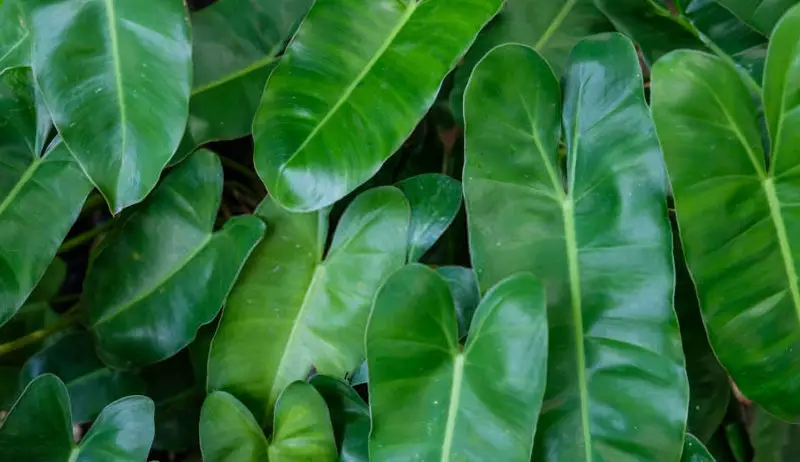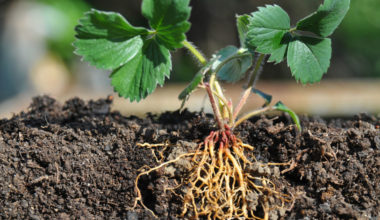In the gardening world, plants covered with a layer of cutin are called waxy leaves. Indeed, these plants are very interesting to have at home, this extra layer allows them to avoid losing too much water, while protecting themselves against various predators, such as insects and other animals.
If you are wondering which plants fit into this category, we have compiled a list of the 21 best plants with waxy leaves.
These plants have developed such an ability to survive in places where the climate does not provide much moisture, they are able to retain water much more efficiently and for a longer period of time than any other plant.
Contents
21 Plants with Waxy leaves
1. Radiator Plant (Peperomias)
Native to Latin America, the Peperomia belongs to the Piperaceae family. It is about 62 inches high and its foliage is evergreen. This is one of the reasons why it is grown as a houseplant. It provides a year-round decoration thanks to the pretty colors of its leaves.

The peperomia likes the luminous situations but dreads the sun rays, especially in summer.
Regarding temperature, the peperomia tolerates a heated interior in winter but it can also lose leaves if the air is too dry.
2. Bromeliad
Bromeliads are a large family of plants growing in the tropics. They are found wild in the forests of South America and thrive in warm, humid atmospheres. Some thrive directly on tree branches in the heart of large forests.
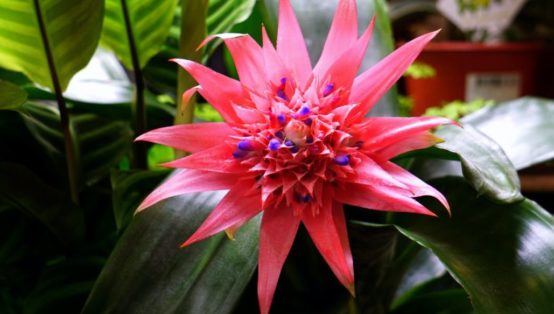
They tolerate heated interiors but require a lot of humidity. Bromeliads are perennial plants with green foliage often slender and rosette-shaped flowers, of various colors, from pink to red through all the oranges and even yellows.
3. Peace Lily
The peace lily (Spathiphyllum wallisii) is very similar to the arum (Zantedeschia) but also to the anthurium (Anthurium andreanum) except for the color: this rhizomatous perennial is a very common houseplant, native to the tropical areas of the Philippines, Indonesia and South America. The hardiness of these plants is limited to 50°F minimum.
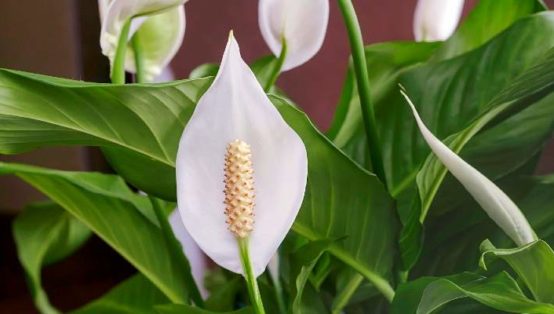
Its dark green evergreen leaves are lanceolate, glossy, with a strongly marked midrib, they spring gracefully from the center of the plant.
4. Hoya Carnosa
The hoya is a tropical plant, used in our region in the interior. Often ignored, it is however surprising, mysterious, and capable of offering a spectacular bloom in porcelain flowers…
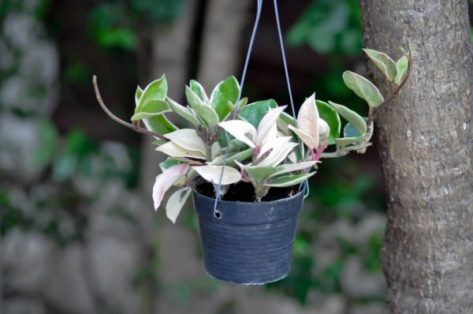
Sometimes several feets long, as a falling vine, climbing or crawling, bushy or upright, the Hoya is a semi-succulent tropical plant particularly spectacular. Robust and easy to live with, it will surprise you with the beauty of its fleshy and waxy flowers: “umbels”, most often composed of dozens of small upright stars, which seem to be made of porcelain, hence its nicknames “porcelain flowers” or “wax flowers”.
5. Heartleaf Ice Plant (Mesembryanthemum Cordifolium)
The Mesembryanthemum or Ficoide forms a small annual tapestry plant is native to South Africa. The clump, with succulent foliage, does not exceed 15 cm and offers during all the summer flowers with the varied colors (pink, mauve, purple, red yellow and even white) with the aspect of daisy.
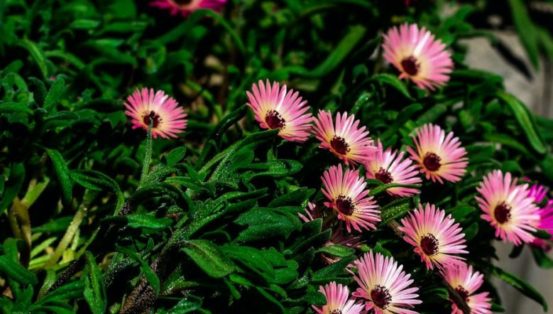
These flowers open only in the sun and close in the evening. The Mesembryanthemum is very resistant to drought. They bloom during the day and close in the evening.
6. Pothos
Pretend you’re the most famous rainforest man with this true indoor creeper. Not only will it give you a wild side, it will also sanitize your home.
Native to the rainforests of Southeast Asia, pothos is also known as “devil’s ivy. A true liana, the pothos can reach 3 ft long when grown indoors. Its heart-shaped leaves alternate on either side of the central stem.
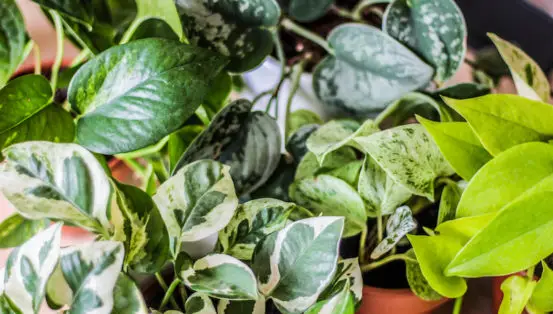
They are rarely plain but rather mottled or marbled, which is what makes them so interesting. It is a liana with aerial roots, which clings to trees in its natural environment. It is easy to cultivate and grows relatively quickly. It presents a falling or climbing port according to whether you support it or not.
7. Carissa Holly
Carissa Holly is a shrub with winter interest. It is very popular because of its glossy foliage and its bright bacciform fruits.
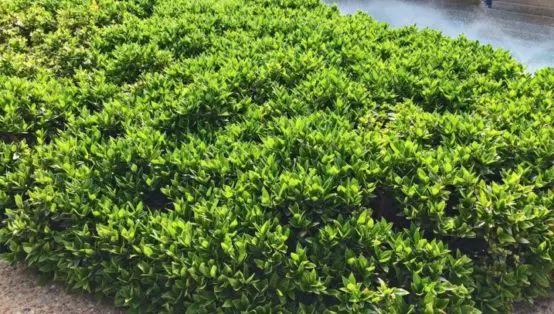
It likes to be exposed to the sun and tolerates cold, sea spray and pollution. Pruning it helps to maintain its attractive habit. It fears aphids and the Carissa Holly fly. Use it in undergrowth, topiary or as a defensive hedge.
8. Zanzibar Gem (Zamioculcas Plant)
Deep green, the Zamioculcas warms the atmosphere and requires little care. Indeed, thanks to its stems which make reserve of water and nutritive elements, it is very enduring. Its code name is ZZ as its name indicates in Latin: Zamioculcas zamiifolia. For a few years, it has made the happiness of our interiors.
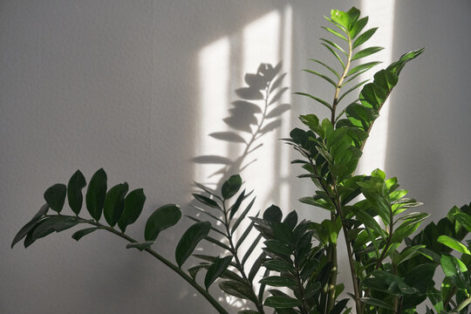
The Zamioculcas needs a lot of light to grow, but it is also content with a little shade. It will know how to adapt without being difficult. However, avoid exposing it to direct sunlight, as it may dry out.
9. Anthurium
The anthurium is a popular plant for interiors thanks to its long, elegant and vibrant blooms. Don’t have a green thumb? Don’t panic, this beautiful tropical is very easy to grow, even for beginners!
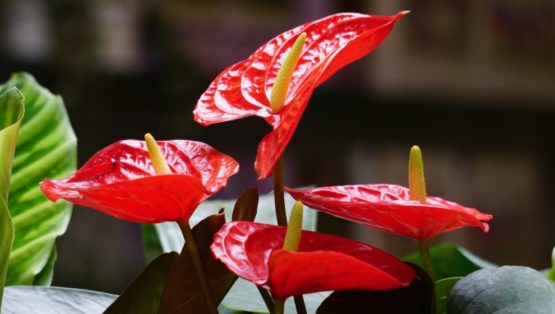
As with most epiphytes, the substrate is very important. Grow anthuriums in an orchid mix. Make sure it is well waterlogged when repotting. You can add sphagnum moss, which tends to hold moisture well.
10. Jade Plant (Crassula Spp.)
The genus Crassula includes nearly 300 species of succulent plants, i.e. adapted to arid conditions, because they store water in the form of juice in their leaves, stems and roots.
Originating from Southern Africa or Asia, crassulas present a great morphological diversity, offering variable forms from a few centimeters to several meters in height.
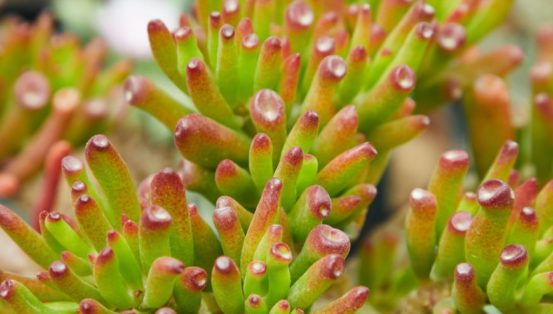
They have however similarities like a great longevity, opposite leaves and starry flowers gathered in panicles. The flowerings, generally autumnal or winter, intervene only on the old plants.
11. Swedish Ivy
In the genus Swedish Ivy, of the family Lamiaceae, we find species born in South Africa, Madagascar and others in Australia. Some of them are grown indoors, while others decorate beds and seasonal pots, to be brought in the veranda in winter, because all Swedish Ivy are freezing.
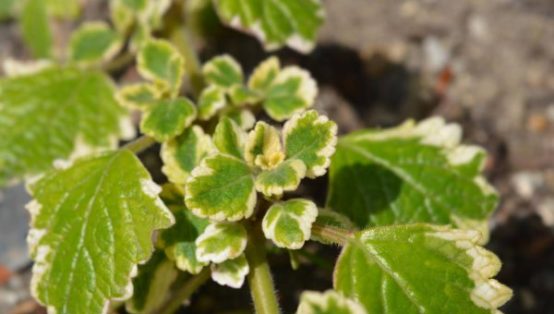
There are many different species and varieties that share the same soft, evergreen, toothed, downy foliage, producing mauve, pink or white flowers in summer. They all have quadrangular stems. To the touch, they give off a very characteristic, slightly minty smell. Shapes and colors vary: upright, creeping or spreading.
Install them in beds or as seasonal ground cover. Creeping and drooping varieties and species are perfect for giving a natural look to pots, planters and hanging baskets.
12. Mistletoe Fig (Ficus Deltoidea)
The genus Ficus belongs to the family Moraceae and includes about 900 species of trees, shrubs and vines. Some species of the genus are Ficus deltoidea, Ficus elastica, Ficus benjamina, Ficus lyrata, Ficus radicans, Ficus pumila, Ficus ingens, Ficus retusa, Ficus carica, Ficus cyathistipula, Ficus binnendijkii, Ficus rubiginosa.
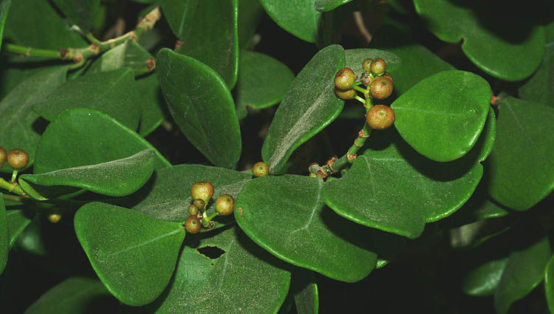
It is also known by the scientific name of Ficus diversifolia.
Although it is a large shrub or tree usually not exceeding one meter in height grown in pots. It has nice glossy and leathery leaves of more or less circular shape. They can produce flowers indoors almost all year round. Unlike their relatives the fig trees, their fruits are not edible.
They are generally used as a houseplant because it is a tropical plant that does not withstand the intense cold. In Barcelona, it can be seen outside in pots at the entrance of stores and hotels.
13. Echeveria Succulent
The vast genus ‘Echeveria’ includes more than 150 species and a multitude of varieties of succulent plants. From the Crassulaceae family, these plants with a graphic habit come from the semi-desert areas of Texas, Central America and Mexico.
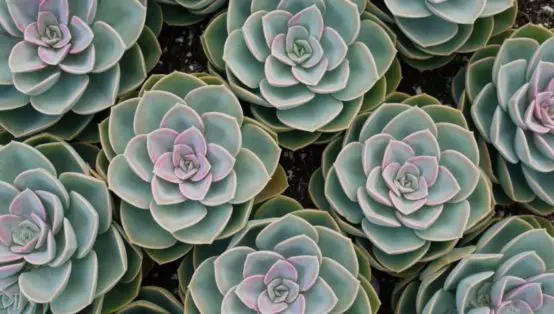
The fleshy leaves with colors varying from gray to various shades of green through purple form beautiful rounded rosettes. The flowers, gathered in clusters and carried by long peduncles, are born in the axils of the leaves in spring and early summer.
Echeverias are very easy to grow in pots in a bright apartment. In the South, these plants will wonderfully adorn the foreground of a bed or a dry and sloping rock garden.
14. Swiss Cheese Plant (Monstera Deliciosa)
Native to the rainforests of South America, this is the must-have plant of today’s jungle trend. Beware, we warn you, you need space to grow the Monstera Deliciosa at home. Its growth is fast and it is able to grow very high… Until 60 ft. If we swear you! But don’t worry, it is very rarely the case in our apartments.
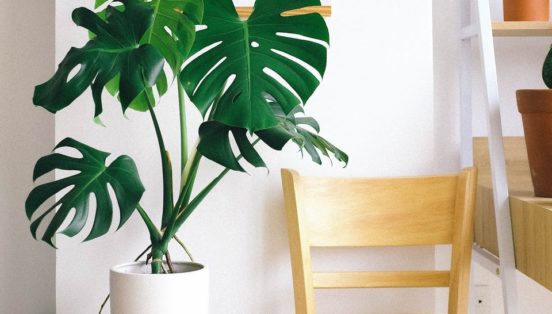
It is a climbing plant which has the characteristic to develop long aerial roots allowing him to catch the humidity of the air. When it is small its foliage is not cut. It is while growing that its leaves are cut and perforated. In the wild, this allows them not to tear in case of strong winds.
15. Rubber Fig (Ficus Elastica)
Rubber Fig (Ficus elastica Roxb. ex Hornem of the Moraceae family) has two habitats. In its original habitat, the tropical forests of Asia, it is a large tree of several tens of meters high. It is also cultivated as a houseplant, but does not exceed two meters.
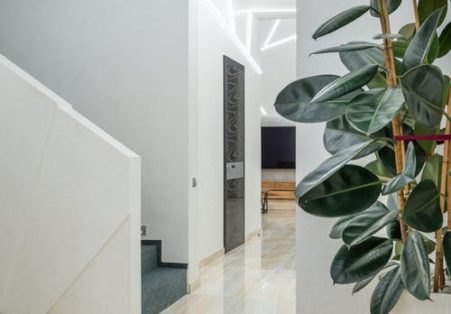
In a pot (in an apartment), the Ficus elastica called Rubber has an upright habit with few secondary branches. The development of the leaves is particular. The bud is protected by an elongated sheath. When the leaf unfolds, this sheath falls and a new leaf develops inside the previous one.
16. Acanthus mollis
The Acanthus mollis is a perennial plant with semi-perennial foliage, it has a tough stump with thick roots and emits beautiful long, green, shiny, soft to the touch and widely serrated leaves.
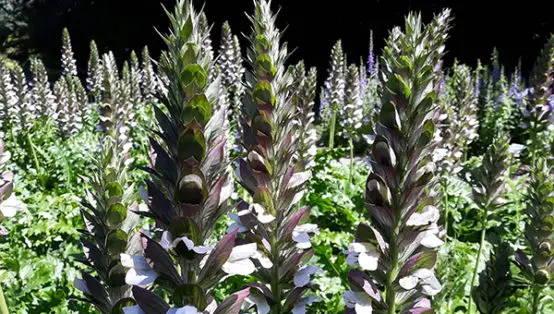
The flowering takes the form of large and numerous floral stems, most often composed of mauve bracts, each one topping pinkish white flowers. They bloom from the bottom to the top, allowing the flowering to last several weeks, most of the time between July and October.
Finally, because it is not particularly delicate, this plant adapts very well to many situations.
17. Darmera peltata
From a distance, the Darmera could be confused with the famous Gunnera or Giant Rhubarb, but once you get a little closer, there is no doubt. Its large round and serrated leaves are carried by stems of frail but quite rigid aspects which makes them relatively tough. And during autumn, they will adopt here and there, very beautiful purple, red and orange colors.

Its powerful and rather tracing stump will not be for all that invasive and will release towards April, well before the foliage, of beautiful small pale pink flowers in clusters, positioned at the top of long straight stems which can exceed one meter in height.
18. Farfugium japonicum ‘giganteum
This very uncommon Asian plant is often related to the Ligularia because of its round and green foliage which is very similar to them. The Farfugium is particularly tough and persistent (until -4°F in good conditions of culture), in spite of the rubbery and varnished aspect of its leaves which reminds a little that of plastic. Its culture is possible as well in full ground as in big pots.

Finally, at the end of autumn, you can admire beautiful small yellow flowers in clusters.
19. Fatsia japonica
Even though it is a shrub, not a perennial, Fatsia deserves its place in the category of large foliage plants. With its exotic appearance, one might think that it would not be hardy in CA but think again! It easily holds up in the open ground and in the right conditions, at temperatures up to 14°F without protection. Its imposing evergreen leaves, pale then dark and shiny, are cut into 7 to 9 distinct lobes.
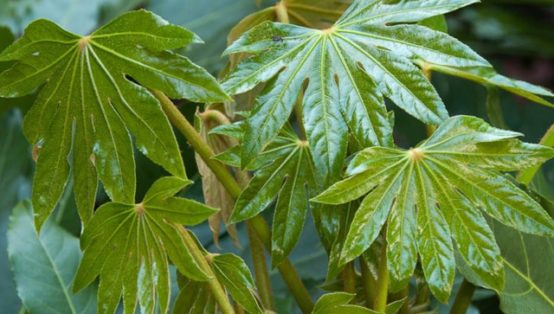
The flowering tops the leaves and is composed of large panicles of round umbels, themselves composed of dozens of small creamy white flowers.
20. Hosta ’empress wu’
To date, this is the biggest Hostas in the world! Usually of reasonable size, this one borders on the insane even though it has the exact same shape and requirements as hundreds of other Cultivars. Carried by a thick and well anchored stump, its imposing thick and ribbed leaves unfold, offering a delightful show of green and bluish colors.
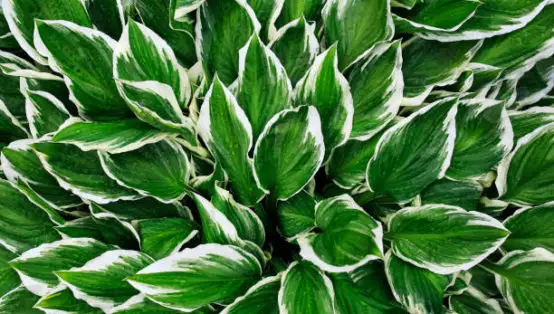
It blooms in the summer, forming erect inflorescences of pretty trumpet-shaped purple flowers pointing to the ground. If you collect Hostas for their original colors and shapes, installed at the bottom of a bed, this one will form a very beautiful gradation and especially a magnificent effect of mass.
21. Podophyllum ‘kaleidoscope’
This rare plant is not only original by its imposing foliage, but also by its color and its shape. The leaves are somewhat prehistoric in appearance, round yet octagonal and covered with a kaleidoscope-like pattern, hence the name. The underside of the leaves is covered with a fine soft down, which is also found on the stem.

From May to July, small clusters of two or three flowers appear in the axils of the upper leaves. Like small spiders, their heart is round and their petals rather hooked, the whole with a magnificent smoothness and a beautiful purple color reminding the center of the foliage during summer.
Cultivate it in very little windy, humid and especially well shaded environments as in undergrowth for example. Don’t be afraid, its installation is slow but it has a very good longevity if you don’t move it constantly.
